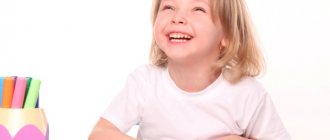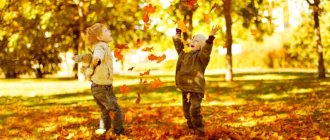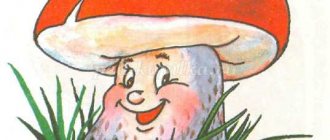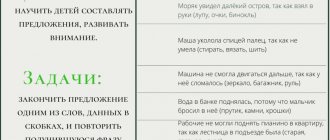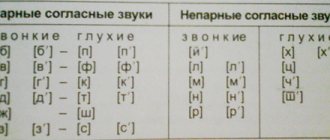The importance of didactic games and toys in the education of young children
Educational games and educational toys are of great importance in the learning, learning and development of young children. After all, it is a game and a toy that can simultaneously teach, educate and bring joy to a child.
From an early age, a child actively learns about the world around him, through studying what is happening around him. In this knowledge, he is actively helped by educational games and toys, which help expand the child’s horizons, teach him to observe and highlight the characteristic features of objects, and establish simple relationships between them.
Too lazy to read?
specialists and get an answer in 15 minutes!
Ask a question
Educational games and toys are of particular importance in the education of young children, since with their help children learn and assimilate the norms and rules of behavior in society and acquire skills of interaction with others. All these skills are necessary for children not only for successful subsequent studies at school, but also for successful socialization in society.
Observation 1
A didactic game and a toy are inseparable from each other. Thus, an educational toy can become the beginning of a game during which a storyline unfolds that requires additional toys.
The value of educational games and toys is that they introduce children to life, promote their mental development and provide opportunities for all types of children's activities.
Lapbook “Toys”. Didactic games for primary preschool age
Yulia Sochilova
“Toys” Lapbook. Educational games for preschoolers
Lapbook. Toys. (for younger children)
This laptop can be used to introduce toys on the topic “Toys”, you can repeat the topic “Toys”. Lapbook is inert in working with children in groups and individually, as well as in relation to lessons in the evening, outside of lessons, parents can consolidate their knowledge on the topic of toys together with their children. This laptop includes a variety of educational games: 1 One-Many Educational Game. Goal: to develop the ability to distinguish between the number of objects, many and one.
.2, didactic game Dress the doll Purpose: to teach children to choose and name suitable clothes (for girls. For boys to develop aesthetic taste.
.3 didactic game The fourth extra object Purpose: to strengthen in young children the ability to find the fourth extra object and explain why the object is extra.
.4 didactic game Circle and color Purpose: To develop fine motor skills, a sense of color, perseverance, and accuracy in young children.
.
.5 educational game Find my shadow Purpose: to teach young children to find given silhouettes of objects, animals, toys; develop children's visual perception, attention, and observation skills.
.
.6 didactic game Dress up the matryoshka Purpose: to teach young children to memorize geometric shapes (circle, square, rectangle, triangle, teach to group objects by color, correlate geometric shapes by shape by overlapping.
.7 educational game Cropped pictures Purpose: to teach young children to form a whole consisting of two parts, to develop logical thinking, visual perception, and attention.
What else to read: Organizing a story game in kindergarten
.8 educational game Consider and color Goal: to develop visual perception in young children, the ability to guess and name a toy, choose the color of a pencil for coloring a toy, the ability to hold a pencil correctly, develop fine motor skills, develop accuracy and consistency,
.
.
.9 didactic game with lacing My toys Purpose: to teach young children to correctly name a toy according to its external characteristics according to poems read by adults in order to make up a story about this toy (why do you need such a toy, like plays with it, the one who plays with it, develops and replenishes vocabulary, finds the necessary parts of the toy and connects with a rope, develops fine motor skills.
educational game .ten Collect a picture Purpose: To introduce young children to a variety of toys, do exercises on creating pictures from geometric shapes (you can use a constructor)
develop sensory perception of fine motor skills of the hands.
Is the potential of the toys available in kindergarten sufficiently realized?
You can justify pedagogical failures by insufficiently modern play equipment for groups, or you can, having only “basic” toys at your disposal, make their “utility coefficient” maximum. For example, it is one thing to offer boys day after day to tinker with a finished railway, directing a train with carriages along it; then put it on the top shelf. And another thing is to once ask them to come up with a plot for a game in which passengers, conductors, purposes of the trip, etc. will appear; the second time - experiment with the trajectory of movement, and the third time - focus on changing the number of trailers.
Objectives of didactic games and toys
The main objectives of using educational games and educational toys in teaching young children:
Too lazy to read?
specialists and get an answer in 15 minutes!
Ask a question
- Enrich your child's sensory experience by promoting perceptual development.
- Development of logical thinking, memory, observation, ability to express one’s feelings and thoughts.
- Sensory development.
- Nurture discipline, correctness, honesty, order and strong-willed qualities of the child’s personality, observing the rules of the game.
- Formation of moral concepts and ideas, assimilation of generally accepted norms and rules.
- Education of aesthetic feelings.
Didactic games as a method of teaching young children have their own specific structure:
- Orientation: the child knows the theme of the game, its rules, general course and content.
- Preparing for the game: distribution of roles, familiarization with game actions, consideration of current procedural tasks.
- Direct play: children play independently, the teacher only observes the progress of the game and, if necessary, helps, corrects or guides.
- Discussion of the game: Analysis of the game is carried out in the form of discussion.
In educational games, in addition to didactic material, educational toys are often used. Various cones, turrets, pyramids, spheres, mosaics, etc. are used as educational toys.
Speech game with toys 1. “Guess which toys are gone”
We teach the child to use words - the names of toys in the genitive plural.
Meet me! This is brother and sister. Their names are Tanya and Vanya.
Tanya and Vanya have a lot of toys. Look at the picture and name Tanya’s toys (dolls, nesting dolls, jump ropes, bears, ducklings, pyramids).
Let's play with Tanya's toys. I will hide the toys, and you can guess what is missing (cover one picture with your palm or finger and ask: “What is missing?”). The child tries to guess and answers: “There are no more dolls.” If you use a set of pictures, then simply remove one picture, and the child can guess what is missing.
Be sure to praise your child and rejoice with him at the correct answer. If your child made a grammatical mistake (for example, he said: “there are no more jumping ropes or ducklings”), do not repeat the mistake after him. Instead, immediately say the correct option: “You guessed right. Well done! There are no jump ropes."
Now look at Vanya’s toys. What toys does Vanya have? (Cubes, drums, planes, cars, balls, shovels, horses). Let's play with them (“there are no more cars, balls, etc.”).
pictures of toys that can be used for this game in the article “Pictures: Children's Toys”, which will be published tomorrow. All the pictures are of good quality, they can be printed on a printer or included in a presentation, made into a game of paired pictures, or viewed with children and asked riddles.
You can also use real toys for the game (two bears, two cubes, etc.)
Didactic games for preschoolers 3 - 5 years old
Formation of spatial orientations in children 4 years of age
Educational games for children 3-5 years old Author: Maria Viktorovna Komova, teacher of secondary school No. 1912, Moscow, Zelenograd Description of the material: The material will be of interest to teachers working with younger preschoolers, as well as to parents raising children 3-5 years old. Games are used both in direct educational activities and in free time, while walking. Goal: To develop the ability to navigate in space in children of primary preschool age. Objectives: teach children to distinguish and name parts of the body, face, distinguish between right and left hands, navigate in the directions bottom-up, back-to-front, left-right, activate some “spatial” prepositions in their speech (under, instead of, with, about , near). 1. Game “What has changed?” Purpose: to show that spatial relationships between objects can be replaced: an object that was above can be below, and vice versa. The game uses a set of toys and a ladder. On the top step, the toys are lined up one after another. First, with the children, we find out who is next to whom, then we change the position of the toys. Children answer the teacher’s questions: “What has changed?” Questions for children: who is below, above, next to? Who is to the right of the duckling? Who's to the left of the rabbit?
What else to read: Environmental education of preschoolers through play
Children were asked to close their eyes
What changed? “The bunny jumped off the ladder” (Borya)
2. Game activity “Where was the bear looking for the ball?” The bear's area of action is limited. Educational material - furniture for dolls (table, chairs, sofa, bed, wardrobe, bedside table), life-size doll - bear and ball. Program content: to attract children's attention to various options for spatial relationships between objects. Activate some “spatial” prepositions in their speech (under, instead of, with, approximately, next to) ... Teach children to change the endings of names when using various prepositions (on a chair, under a chair, near a chair, etc.: Bear comes to visit the children.
The teacher tells the children that the bear wants to play with the ball, but the ball rolled somewhere. The search for the ball begins. The teddy bear looks under the reading, under the table, under the wardrobe, under the sofa, under the chair, looking for a ball for the sofa, for the closet, he looks inside v closet e v bedside table; Then he goes to the closet and finally finds the ball in the trash can. While looking for the ball, the teacher talks to the children. Asks questions: “Where is the bear going now?”, “What is he doing?” Corrects inaccuracies in children's speech, invites everyone to tell together where the bear is looking for the ball.
Then the children were asked to play hide and seek with a teddy bear: “Now you yourself will hide the toys in different parts of the room. And the bear will watch. Think about where you would like to hide the howling toy." The teacher invites everyone to tell where they want to hide their toy, and then hide it. The toys are hidden, the bear begins to search. Children carefully watch his actions, and I will be happy to answer questions about where he found the toy. 3. Game-activity “Find a toy.” In the absence of children, the teacher hides toys in places accessible to children in the group room and offers to find them. “Everyone will find only one toy. Make sure you remember where you find your toy and then tell all the kids about it." Children begin to look for hidden toys with interest. When the toys are found, the teacher asks the children to tell where they were hidden. Another version of the game. One of the children closes his eyes, the others hide the toy on the table, under the table, on the closet. At a signal, the child opens his eyes and begins to look for the toy. Having discovered it, he explains where the toy was. 4. “Where are your hands?” Task: hide your hands behind your back. The teacher first guesses where the child’s right hand is and where the left is, then invites one (or several children) to show their hands and name them. 5. “Where is the toy?” Task: hide the toy in the palm of your hand. The teacher’s task is to guess whether he is in the right or left hand. Then invite the children to show their hands one by one: right and left, name them, tell them in which hand the toy is hidden. 6. “Tick the checkbox.” The teacher invites the children to remember what the right (left) hand is and take the flag; transfer the flag to the other hand, raise your hand, wave the flag and move it back to the right. Or: blue flag (ribbon) in the right hand, yellow flag in the left. Task: swap the flags. After this, the teacher asks: “What color is the flag? In which hand? The game “Catch the Flag” was played with children in subgroups
What else to read: Didactic game “Speech Cubes” for older preschool children
We greet with the left hand, and now with the right
7. “Move the chestnuts to your other hand.” Several chestnuts (5-6) need to be transferred one at a time from one hand to the other. During the exercise, the child shapes his hands and labels them. At the same time, the concepts of “one” and “many” are reinforced in children.
Role-play situations to maintain interest in classes and create a positive emotional mood. Purpose: to delineate the spatial arrangement of body parts (arms, legs, eyes, ears). Material: life-size “Bear” doll; red, blue circles depending on the number of children in the group. Lesson Course: Guys, do you hear someone knocking on our door? Let's see who's there? Mishka came to visit us. He wants to see how we take care of you. Children are sitting on the carpet. Guys, please show me your right hand, and now your left. Nadya, show your right hand, Nikita - your left... Take a red circle in your right hand, raise your hand and show the circle to Mishka. Now take the blue circle in your left hand. Show the circle to Mishka. The bear wants to ask Seryozha what he is holding in his right hand. In which hand is Dima holding the blue circle? Now let's play. The boys keep a short distance from each other. Put your hands down. Now raise your right hand up and your left hand down. Now stretch your arms forward, raise your right arm to the right, your left arm to the left, lower your arms. Touch your right knee with your right hand and touch your left knee with your left. Pat yourself on the knee. Very good! Now we are sailing on a ship and decided to look through a telescope. The tube was first attached to the right eye and then to the left eye. Pinocchio heard a rustling in the toilet. He listened, placing his hand first on his right ear and then on his left. Now let's become storks. Raise your right leg and stand on your left. “A stork walks through a swamp, a stork is looking for a hippopotamus.” Let's change legs, now stand on the right leg and raise the left.
We recommend watching:
Sensory educational game for kindergarten Fun games for kindergarten Family work game Fun game for middle age children
Speech game with toys 3. Bunnies
Let's get acquainted with toy bunnies: part 1.
We teach kids to describe pictures of toys, compare, analyze, use verbs exactly according to their meaning (distinguish between perfective and imperfective verbs), use diminutive suffixes (baby, bunny, hare, hare, eyes, ears, tail, etc. ).
To play, you will need a picture or three toy bunnies, which you will dress in different ways. These can be bears, dolls and any other toys instead of bunnies.
The first bunny is Shustrik. He is wearing a jacket and trousers. The second is Toropyzhka. He is wearing a jacket that is buttoned incorrectly - as a result, one bottom edge is higher than the other, sticks out unattractively, his hat is on his side, his scarf is tied sloppily on his side. The third one is Catch-up. He hasn't had time to get dressed yet, he's only wearing trousers.
Look at pictures or toys with your child and tell him a story about three bunnies.
“Vanya and Tanya live with three toy bunnies. The first bunny is always in a hurry, in a hurry and therefore does a lot of things wrong. That’s what the guys called him – Toropyzhka. Find it in the picture. How did you guess that it was Toropyzhka?
The second bunny does everything deftly, skillfully, quickly, correctly, smartly. Can you guess what his name was? What would you call an agile, nimble bunny? Interesting names you came up with! Do you want to know what Tanya and Vanya called him? They called him Shustrik because he was very... (smart).
The third bunny is always late, does not have time, and does things very slowly and leisurely. They often tell him: “Catch up with us.” That's why they named it - what do you think? Give him a name that makes it clear that he does everything slowly. What would you call such a bunny? (Encourage any option the child has - this is his word creation, and offer your own options). And Tanya and Vanya called him that - Catch-up.
Find Shustrik and Catch-up in the picture. How did you guess that this is Shustrik, and this is Catch-Up (the child explains).
Playing riddles: part 2.
These toy bunnies are brothers. They are very similar to each other. How are they similar? (They have long ears, short tails, round eyes, small noses, they are white, fluffy, they can jump, they love carrots, etc.).
How are bunnies different? (Look at clothes, shoes, eyes, noses, what the bunnies do).
How can you call a bunny affectionately? (Bunny, bunny, bunny, bunny).
What is the affectionate name for a bunny's ears? Yes, ears.
What is an affectionate name for your nose? (nose).
Eyes - ? (eyes)
Paws - ? (paws)
Tail? (tail)
Let's play riddles. I'll wish for a little bunny, and you guess his name.
You describe a bunny - a toy or a bunny from a picture, and the child must guess his name.
“This little bunny is very cheerful. He has big blue eyes. The bunny's nose is black and small. The bunny's ears are long and his tail is short. He is wearing a red jacket and blue trousers. The jacket has a blue collar and many round buttons. The little bunny loves to sing songs. Who is this?"
Now tell me a riddle: “My little bunny... He has.... The eyes of a bunny... The little bunny has a nose... Bunny loves...” (We help the baby construct a statement - a description, giving him support - the beginnings of phrases).
Who does what: part 3.
Every morning Tanya and Vanya play with the bunnies. Look at the toys (act out a scene). Toropyzhka and Shustrik have already gotten out of bed (we show), and Catch-up is still getting up. And it always happens. Listen and guess who is doing what (the child finishes the end of the phrase by analogy).
- Shustrik has already washed his face, and Catch-up is still... (washing himself).
- Shustrik has already gotten dressed, and Catch-Up is still...(getting dressed).
- Shustrik has already brushed his teeth, and Catch-Up is still...(cleaning).
- Shustrik has already had breakfast, and Catch-up is still...(having breakfast).
- Toropyzhka and Shustrik are already getting ready for a walk, and Catch-up is still...(getting ready).

